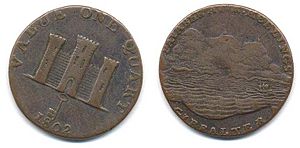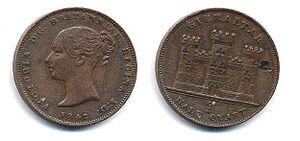Gibraltar real facts for kids
The real was the official money used in Gibraltar until 1825. It continued to be used alongside other Spanish and British money until 1898.
Contents
History of Gibraltar's Money
After British and Dutch forces took over Gibraltar in 1704, the Spanish real was still used there. However, people didn't treat the silver reales (called de plata) and the cheaper metal reales (called de vellón) differently. This meant army officers could make extra money when paying soldiers. For example, before 1737, one silver real was worth two cheaper ones, but they were often treated as the same.
In 1741, new exchange rates were set. For instance, 16 quartos made one real de vellón. Also, 10 reales de vellón made one peso fuerte, which was also known as the Spanish dollar. These new rates made the real de vellón worth about twice as much in Gibraltar as it was in Spain. Most of the money used was copper coins. This was because silver coins were worth less in Gibraltar compared to the cheaper metal coins, so most silver was sent out of Gibraltar to Spain. Between 1802 and 1820, copper tokens called quarts were also made by merchants.
In 1825, the values of the different coins were changed again and linked to the British pound. The silver real was divided into 24 quarts. The Spanish dollar was valued at 4 shillings and 4 pence. British silver coins were brought in. But because the dollar's value was set too high, British silver coins didn't circulate well. However, British copper coins did, with one quart informally valued at one farthing. This difference also allowed army officers to make a profit when paying soldiers.
In 1842, new coins were made in ½, 1, and 2 quarts values. A total of 387,072 quarts worth of coins were made. This allowed soldiers to be paid in quarts instead of pence. Other coins were still used until 1872. In that year, only Spanish money became legal in Gibraltar. In 1898, the Spanish–American War caused the Spanish peseta to lose a lot of its value. So, on October 1 of that year, the Gibraltar pound was introduced as the only money in Gibraltar. At first, this was in the form of British coins and banknotes.
Merchant Tokens (1802–1820)
Traders in Gibraltar made their own money tokens between 1802 and 1820. These were made by Robert Keeling, Richard Cattons, and James Spittles. There were two values: 1 quart (or quarto) and 2 quarts (or 2 quartos).
Robert Keeling's Tokens
| Year | Value | Front (Obverse) | Back (Reverse) |
|---|---|---|---|
| 1802 | 1 quarto | View of The Rock from The Bay and 'Payable at R Keeling's Gibralter' | Castle and Key |
| 1802 | 2 quartos | View of The Rock from The Bay and 'Payable at R Keeling's Gibralter' | Castle and Key |
| 1810 (small date) | 1 quarto | Lion and key and 'Payable at Robert Keeling & Sons Gibraltar' | Castle |
| 1810 (small date) | 2 quartos | Lion and key and 'Payable at Robert Keeling & Sons Gibraltar' | Castle |
| 1810 (large date) | 1 quarto | Lion and key and 'Payable at Robert Keeling & Sons Gibraltar' | Castle |
| 1810 (large date) | 2 quartos | Lion and key and 'Payable at Robert Keeling & Sons Gibraltar' | Castle |
Richard Cattons' Tokens
| Year | Value | Front (Obverse) | Back (Reverse) |
|---|---|---|---|
| 1813 | 1 quarto | Lion and key and 'Payable at Richard Cattons Goldsmith' | Crown and Wreath |
| 1813 | 2 quartos | Lion and key and 'Payable at Richard Cattons Goldsmith' | Crown and Wreath and Agente para la fabrica de diamantes patentes de Duddell Holborn Londres (meaning: Agents for making Duddell Holborn's patent diamonds in London) |
James Spittles' Tokens
| Year | Value | Front (Obverse) | Back (Reverse) |
|---|---|---|---|
| 1818 | 2 quartos | Lion and key and 'Payable at James Spittles' | Moorish Castle |
| 1820 | 1 quarto | Lion and key and 'Payable at James Spittles' | Moorish Castle |
| 1820 | 2 quartos | Lion and key and 'Payable at James Spittles' | Moorish Castle |
Coins (1842)
| Year | Value | Front (Obverse) | Back (Reverse) |
|---|---|---|---|
| 1842 | ½, 1 and 2 quarts | Queen Victoria and 'Victoria D:G: Britanniar: Regina F:D: 1842' (meaning: Victoria, by the Grace of God, Queen of the Britains, Defender of the Faith, 1842) | Castle and Key. 'Gibraltar' above, value below |
It's interesting to know that test versions of these coins were also made in 1860 and 1861.
See also



